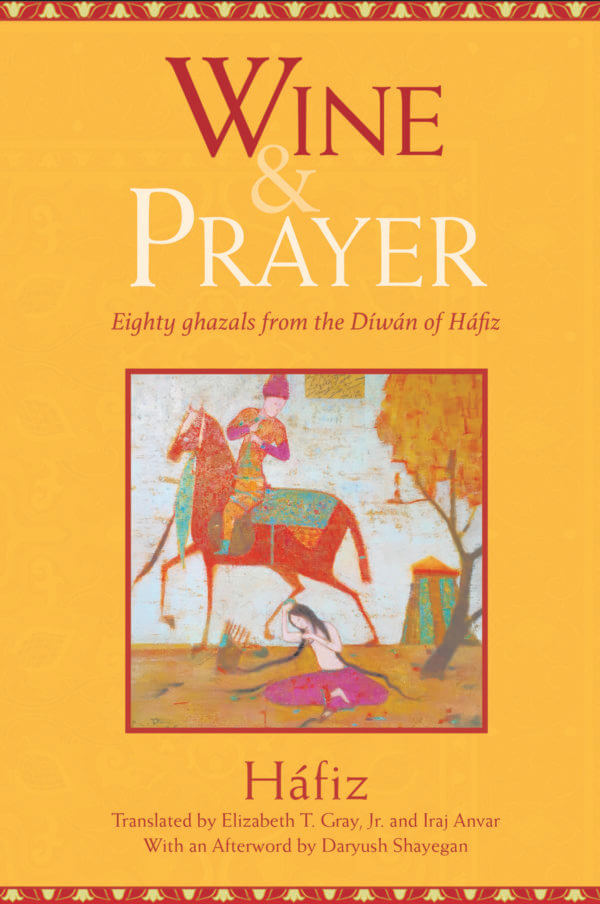“Western scholars of classical Persian poetry have frequently felt humbled before the grand ocean of allusions and historical references, stock phrases and metaphors, ever-recurring images and figures, tantalizing integration of rhythm and rhyme and word-play and meaning, from all of which leaps forth the ghazal—ghazals, the hard-as-rock genre of Persian poetry, of which Hafiz of Shiraz is the unparalleled master. To be sure, the very form of this genre is unique to its own milieu: ghazal is a single poem containing within itself a whole multiplicity of smaller poems: for each verse of the ghazal, the bayt, is an integral whole, related to other bayts only—at least apparently—by a meter that is fixed and by a rhyme that reappears.
Given all this, translating a Persian ghazal is no easy matter. Steeped in tradition, it requires long curtains of explanatory footnotes hanging from the rod of each translated verse; but how clumsy such an exercise would look! And then, the translator must at once be highly learned in the Persian literary tradition and profoundly skilled in poetic craft. These are the twin requirements for those daring ones who undertake this daunting task.
Here is an English translation of fifty ghazals of the great Hafiz: a translation with a rich flow that is surprising, with a vigilant faithfulness to the original that is commendable, and with a tender and learned poetic care that is both a scholarly and an artistic joy. Elizabeth Gray presents us with a bouquet of Shirazi flowers, blazing in their colors and so fresh. She is to be admired both for her erudition and her verbal skills. And more, we must admire her also for her cultural courage.
The plan of this work is very sensible. First, Gray provides a very useful introduction; here she presents the historical setting in which the 14th century Poet Hafiz was composing his ghazals; she explicates the nature of this genre itself, including its formal and technical requirements; she speaks of the challenges faced by a translator; and she utters an authoritative word of caution to the reader: “brandish lightly..the templates of Western literary criticism”[!] (p. xxi). Yes, we must heed her advice.
Then she juxtaposes the original Persian text and her translation; and here there exist no footnotes, no heavy curtains, no clumsiness. To be sure, notes do exist—but far removed from the translations, at the end of the book. This was an intelligent structural decision. These notes are minimal, not too extensive, not too pedantic. And they are highly beneficial. In some cases, they constitute packed short essays on some of the most abstruse stylistic, conceptual, and historical elements of the Persian poetic tradition. It seems, then, that the work has a wide scope: its magnetism would pull scholars, students, and enthusiasts alike.
This is not to say that there is no room for disagreement with Gray, For example, in Ghazal 6, both lines of the third bayt contain the same root word kharab (kharabi/kharabat): why translate them differently (“ruin/tavern”)? One would remain close to the original by maintaining that same root word, and, it seems, such a rendering was easily possible. Also, while pointing out that the Persian language does not admit of grammatical genders, Gray tells us that she has carefully avoided taking a gender decision—but then she actually does, and even though she remains consistent in the sameghazal , her decision is sometimes puzzling. In Ghazal 37, Hafiz, speaking of the alchemist, and at the height of his craft, employs alchemical terminology (bayt 8): “naqd,” which has to do with metal casting; and “sanjad” (from sanjidan), which literally means “weighing”; but ths richness and fullness of the poet’s imagery does not manifest itself in the translation. Here and there one notes also inconsistencies in Gray’s transliterations.
Indeed, Gray is at the peak of her talents when she remains literal. The remarkably powerful ghazalwith the radif (a word repreated at the end of each bayt) “bas!” is just as remarkable in the translation; Gray renders the word literally: “enough!”; and more, she maintains it at the end of every translatedbayt. What a treat to the reader! Again, her translation of “saba” as “dawn wind” instead of the standard “morning breeze” is as fresh as the dawn itself.”
